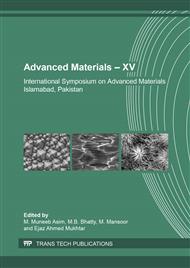p.200
p.206
p.212
p.217
p.225
p.230
p.236
p.245
p.251
Development and Characterization of Teflon-Copper Composite Material
Abstract:
Composites are the combination of materials that are mixed together to achieve specific structural properties. Teflon (Polytetrafluoroethylene PTFE) consists of long-chain molecular structure. Its monomer consists of two carbon atoms each of them having flourine atoms attached. Bonds within each chain are strong covalent bonds where as the secondary bonds between two chains are weaker. By raising temperature, the distance between the chains increases providing good adjustment of the atoms of other materials due to anisotropy of its mechanical properties. Powder metallurgy technique using hot isostatic pressing, a hybrid densification process in which pressure and temperature are applied at the same time, has been used to develop a teflon-copper composite material. Three samples were prepared by changing the teflon-copper composition as 60:40%, 65:35% and 70:30% by weight. Commercially available powders of teflon and copper of grain size ~ 40 μm was used. The aim to develop this type of material was to increase its density (~ 4 g/cm3), and hardness. The commercial applications of such type of composite material are solid lubricants, sleeves, bearings etc. In this paper the effect of composition on hardness, tensile strength and surface roughness is studied.
Info:
Periodical:
Pages:
225-229
Citation:
Online since:
September 2018
Authors:
Permissions:
Share:
Citation:


